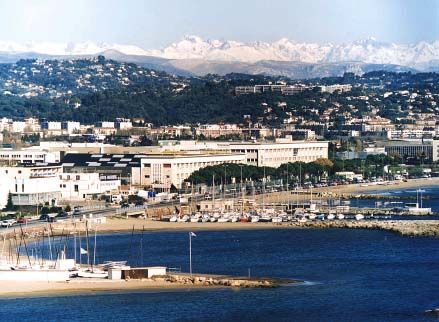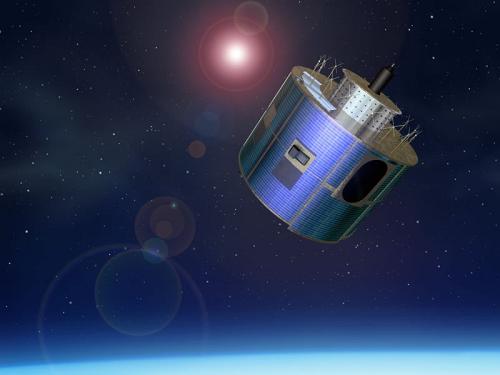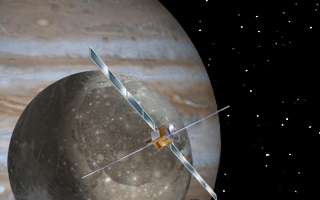|
S400 (rocket Engine)
The S400 is a family of pressure fed liquid propelled rocket engines manufactured by ArianeGroup (former Airbus DS) at the Orbital Propulsion Centre in Lampoldshausen, Germany. They burn MMH and MON as propellant, have a thrust range between and and can vary the O/F ratio between 1.50 and 1.80. The chamber and throat are made of a platinum alloy, it uses double cone vortex injectors and uses both film and radiative cooling. The S400 engines are used as primary apogee engines for telecommunication satellite platforms such as the Spacebus of Thales Alenia Space as well as space exploration missions such as Venus Express, ExoMars Trace Gas Orbiter or Jupiter Icy Moons Explorer. The S400 family has had an extensive history on the commercial telecommunication market. Its first launch was aboard the Symphonie 1 in 1974. This was the first commercial three-axis stabilized communications satellite in geostationary orbit with a bipropellant rocket propulsion system. It also wa ... [...More Info...] [...Related Items...] OR: [Wikipedia] [Google] [Baidu] |
Germany
Germany,, officially the Federal Republic of Germany, is a country in Central Europe. It is the second most populous country in Europe after Russia, and the most populous member state of the European Union. Germany is situated between the Baltic and North seas to the north, and the Alps to the south; it covers an area of , with a population of almost 84 million within its 16 constituent states. Germany borders Denmark to the north, Poland and the Czech Republic to the east, Austria and Switzerland to the south, and France, Luxembourg, Belgium, and the Netherlands to the west. The nation's capital and most populous city is Berlin and its financial centre is Frankfurt; the largest urban area is the Ruhr. Various Germanic tribes have inhabited the northern parts of modern Germany since classical antiquity. A region named Germania was documented before AD 100. In 962, the Kingdom of Germany formed the bulk of the Holy Roman Empire. During the 16th ce ... [...More Info...] [...Related Items...] OR: [Wikipedia] [Google] [Baidu] |
Thales Alenia Space
Thales Alenia Space () is a Franco-Italian aerospace manufacturer. A joint venture between the French technology corporation Thales Group (67%) and Italian defense conglomerate Leonardo (33%), the company is the largest satellite manufacturer in Europe. It is headquartered in Cannes, France. Thales Alenia Space designs and builds various space-related products, notably manufacturing numerous ranges of satellites for telecommunications, navigation, earth observation and space exploration purposes. The company is the second largest industrial participant in the International Space Station (ISS), having produced the European Space Agency's (ESA) modules for the ISS. It is also building satellites for Galileo, a European global satellite navigation system (GSNS). History Thales Alenia Space arose as a result of the French defense electronics specialist Thales Group deciding to buy out the participation of Alcatel in two joint-ventures between France's Alcatel and Italy's Finm ... [...More Info...] [...Related Items...] OR: [Wikipedia] [Google] [Baidu] |
Specific Impulse
Specific impulse (usually abbreviated ) is a measure of how efficiently a reaction mass engine (a rocket using propellant or a jet engine using fuel) creates thrust. For engines whose reaction mass is only the fuel they carry, specific impulse is exactly proportional to the effective exhaust gas velocity. A propulsion system with a higher specific impulse uses the mass of the propellant more efficiently. In the case of a rocket, this means less propellant needed for a given delta-v, so that the vehicle attached to the engine can more efficiently gain altitude and velocity. In an atmospheric context, specific impulse can include the contribution to impulse provided by the mass of external air that is accelerated by the engine in some way, such as by an internal turbofan or heating by fuel combustion participation then thrust expansion or by external propeller. Jet engines breathe external air for both combustion and by-pass, and therefore have a much higher specific impulse than ... [...More Info...] [...Related Items...] OR: [Wikipedia] [Google] [Baidu] |
Meteosat
The Meteosat series of satellites are geostationary meteorological satellites operated by EUMETSAT under the Meteosat Transition Programme (MTP) and the Meteosat Second Generation (MSG) program. The MTP program was established to ensure the operational continuity between the end of the successful Meteosat Operational Programme in 1995 and Meteosat Second Generation (MSG), which came into operation at the start of 2004 using improved satellites. The MSG program will provide service until the MTG (Meteosat Third Generation) program takes over. __TOC__ First generation The first generation of Meteosat satellites, Meteosat-1 to Meteosat-7, provided continuous and reliable meteorological observations from space to a large user community. Meteosat-1 to -7 have all now retired. When operational, the Meteosat First Generation provided images every half-hour in three spectral channels (Visible, Infrared) and Water Vapour, via the Meteosat Visible and Infrared Imager (MVIRI) instrum ... [...More Info...] [...Related Items...] OR: [Wikipedia] [Google] [Baidu] |
Hispasat AG1
Hispasat Advanced Generation 1 (Hispasat AG1), also designated Hispasat 36W-1, is a Spanish communications satellite which is part of the Hispasat fleet. It was successfully launched to GTO on 28 January 2017. The satellite will serve Spain, Portugal and the Americas The Americas, which are sometimes collectively called America, are a landmass comprising the totality of North and South America. The Americas make up most of the land in Earth's Western Hemisphere and comprise the New World. Along with th .... See also * Hispasat 30W-6 References External links Hispasat 36W-1 official page Communications satellites in geostationary orbit Satellites of Spain Spacecraft launched in 2017 2017 in Spain Spacecraft launched by Soyuz-2 rockets {{Spain-spacecraft-stub, nocat=yes ... [...More Info...] [...Related Items...] OR: [Wikipedia] [Google] [Baidu] |
ARSAT-2
ARSAT-2 is a geostationary communications satellite operated by ARSAT and built by the Argentine company INVAP. It was launched from French Guiana alongside Sky Muster satellite using an Ariane 5ECA rocket on September 30, 2015 at 20:30hs UTC, becoming the 400th satellite to be launched by Arianespace. It is licensed to be located at 81° West longitude geostationary slot. ARSAT-2 is the second geostationary satellite built in Argentina, after ARSAT-1. Structurally and mechanically it is a copy of the ARSAT-1, the only difference being the payload and thus it has different antenna configuration. Payload ARSAT-2 payload was supplied by Thales Alenia Space. It consists of both Ku band and C band sections. The Ku band has 20 physical transponders. Of those, sixteen have a 36 MHz bandwidth and four have 72 MHz. Thus the satellite has a maximum capacity of 864 MHz Ku or 24 transponder equivalent. A deployable antenna and a fixed Gregorian antenna. The C band section has a sing ... [...More Info...] [...Related Items...] OR: [Wikipedia] [Google] [Baidu] |
Syracuse (satellite)
Syracuse (french: Système de radiocommunication utilisant un satellite, ''satellite based radiocommunication system'') is a series of French Military satellite, military communications satellites. Syracuse is intended to ensure the French military can communicate between mainland France and military units deployed around the world. The satellite participates in command, reassignment and logistic aspects of operations. The system is nominally under the command of the French Navy, equipping a total of 54 ships (2009) and it is complemented by the Telcomarsat commercial system of communications. Syracuse 1 to 3 Syracuse 1 and 2 were payloads on joint civilian-military satellite designs developed and operated by the Postes, télégraphes et téléphones (France), French PTT, and were more commonly known by their civilian names Télécom 1 (3 satellites in 1984, 1985 and 1988) and Télécom 2 (4 satellites in 1991, 1992, 1995 and 1996). Matra Marconi Space was a development contrac ... [...More Info...] [...Related Items...] OR: [Wikipedia] [Google] [Baidu] |
Bipropellant Rocket
A liquid-propellant rocket or liquid rocket utilizes a rocket engine that uses liquid propellants. Liquids are desirable because they have a reasonably high density and high specific impulse (''I''sp). This allows the volume of the propellant tanks to be relatively low. It is also possible to use lightweight centrifugal turbopumps to pump the rocket propellant from the tanks into the combustion chamber, which means that the propellants can be kept under low pressure. This permits the use of low-mass propellant tanks that do not need to resist the high pressures needed to store significant amounts of gasses, resulting in a low mass ratio for the rocket. An inert gas stored in a tank at a high pressure is sometimes used instead of pumps in simpler small engines to force the propellants into the combustion chamber. These engines may have a higher mass ratio, but are usually more reliable, and are therefore used widely in satellites for orbit maintenance. Liquid rockets can be mono ... [...More Info...] [...Related Items...] OR: [Wikipedia] [Google] [Baidu] |
Geostationary Orbit
A geostationary orbit, also referred to as a geosynchronous equatorial orbit''Geostationary orbit'' and ''Geosynchronous (equatorial) orbit'' are used somewhat interchangeably in sources. (GEO), is a circular geosynchronous orbit in altitude above Earth's equator ( in radius from Earth's center) and following the direction of Earth's rotation. An object in such an orbit has an orbital period equal to Earth's rotational period, one sidereal day, and so to ground observers it appears motionless, in a fixed position in the sky. The concept of a geostationary orbit was popularised by the science fiction writer Arthur C. Clarke in the 1940s as a way to revolutionise telecommunications, and the first satellite to be placed in this kind of orbit was launched in 1963. Communications satellites are often placed in a geostationary orbit so that Earth-based satellite antennas do not have to rotate to track them but can be pointed permanently at the position in the sky where the sat ... [...More Info...] [...Related Items...] OR: [Wikipedia] [Google] [Baidu] |
Attitude Dynamics And Control
Attitude control is the process of controlling the orientation of an aerospace vehicle with respect to an inertial frame of reference or another entity such as the celestial sphere, certain fields, and nearby objects, etc. Controlling vehicle attitude requires sensors to measure vehicle orientation, actuators to apply the torques needed to orient the vehicle to a desired attitude, and algorithms to command the actuators based on (1) sensor measurements of the current attitude and (2) specification of a desired attitude. The integrated field that studies the combination of sensors, actuators and algorithms is called guidance, navigation and control (GNC). Aircraft attitude control An aircraft's attitude is stabilized in three directions: '' yaw'', nose left or right about an axis running up and down; ''pitch'', nose up or down about an axis running from wing to wing; and ''roll'', rotation about an axis running from nose to tail. Elevators (moving flaps on the horizontal tai ... [...More Info...] [...Related Items...] OR: [Wikipedia] [Google] [Baidu] |
Symphonie
The Symphonie satellites (2 satellites orbited) were the first communications satellites built by France and Germany (and the first to use three-axis stabilization in geostationary orbit with a bipropellant propulsion system) to provide geostationary orbit injection and station-keeping during their operational lifetime. After the launch of the second flight model, they comprised the first complete telecommunications satellite system (including an on-orbit spare and a dedicated ground control segment). They were the result of a program of formal cooperation between France and Germany. 1963–1970: Beginnings * January 22, 1963: Signing by President Charles de Gaulle and Chancellor Konrad Adenauer of the Élysée Treaty, an agreement for Franco-German cooperation. Start of preliminary studies in France (SAROS project) and in Germany (Olympia project) of communications satellites. * June 1967: Both countries sign an intergovernmental convention concerning the launch and e ... [...More Info...] [...Related Items...] OR: [Wikipedia] [Google] [Baidu] |
Jupiter Icy Moons Explorer
The Jupiter Icy Moons Explorer (JUICE) is an interplanetary spacecraft in development by the European Space Agency (ESA) with Airbus Defence and Space as the main contractor. The mission will study three of Jupiter's Galilean moons: Ganymede, Callisto, and Europa (excluding the volcanically active Io; Io is not an icy moon) all of which are thought to have significant bodies of liquid water beneath their surfaces, making them potentially habitable environments. The spacecraft is scheduled to launch in April 2023 and will reach Jupiter in July 2031 after four gravity assists and eight years of travel. In December 2034, the spacecraft will enter orbit around Ganymede for its close up science mission, becoming the first spacecraft to orbit a moon other than the moon of Earth. The selection of this mission for the L1 launch slot of ESA's Cosmic Vision science programme was announced on 2 May 2012. Its period of operations will overlap with NASA's ''Europa Clipper'' mission, lau ... [...More Info...] [...Related Items...] OR: [Wikipedia] [Google] [Baidu] |




